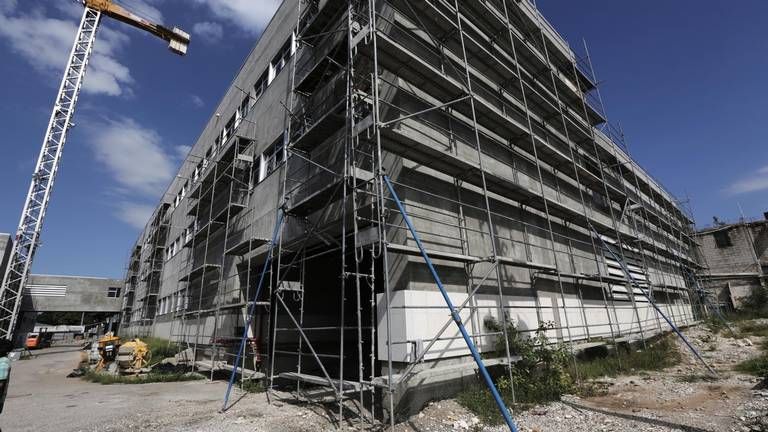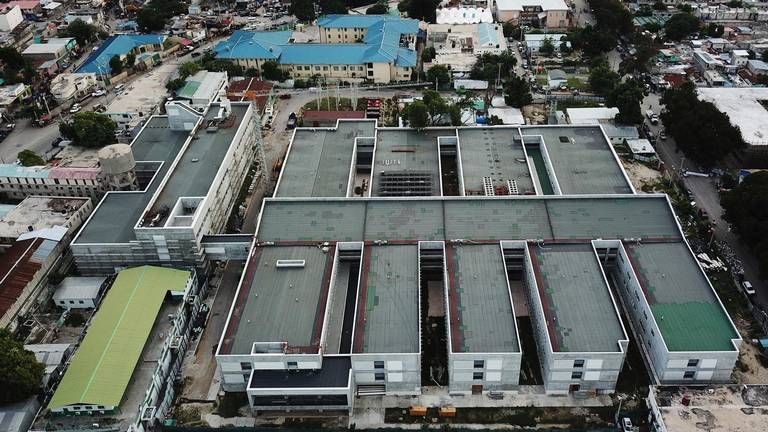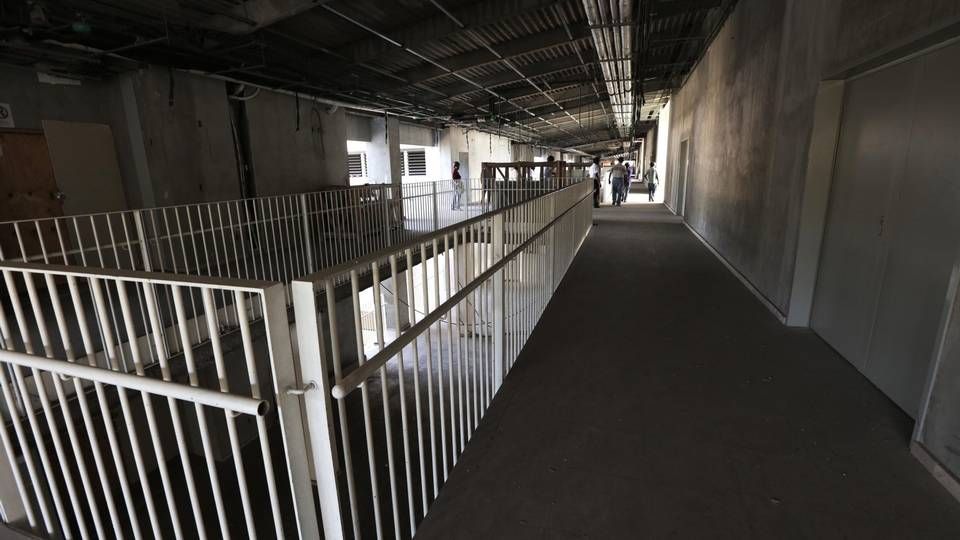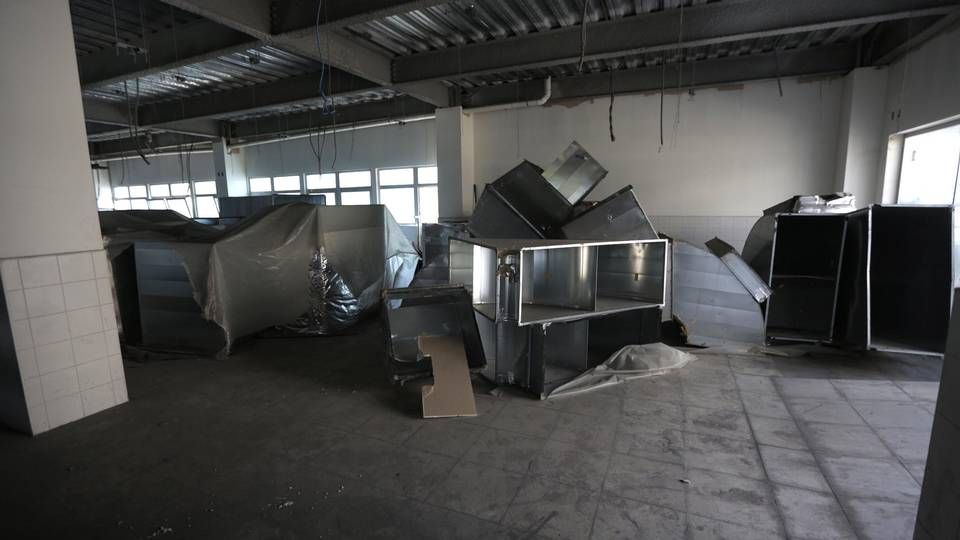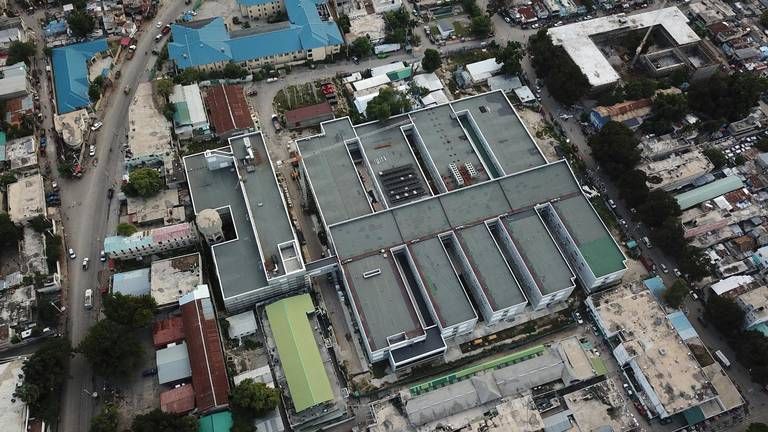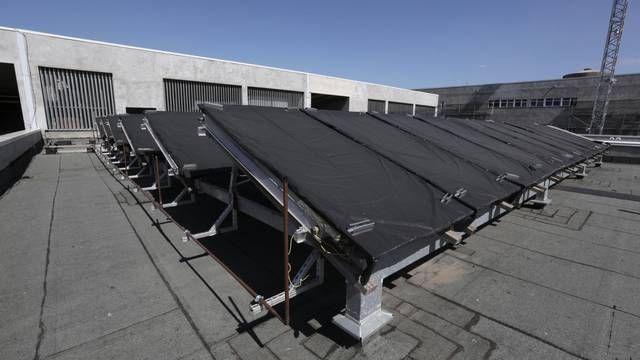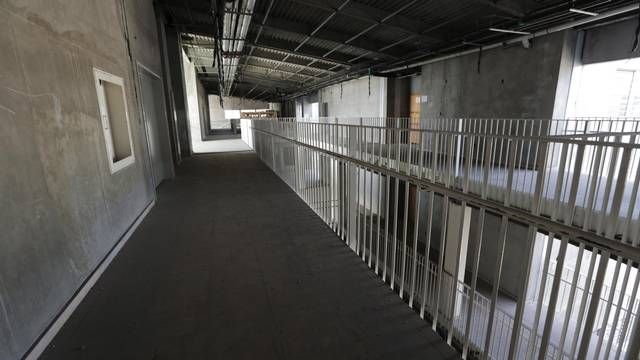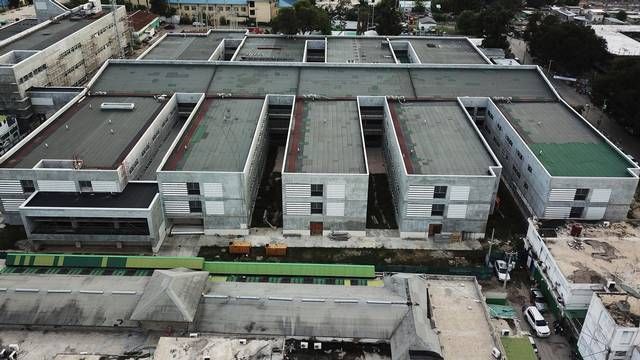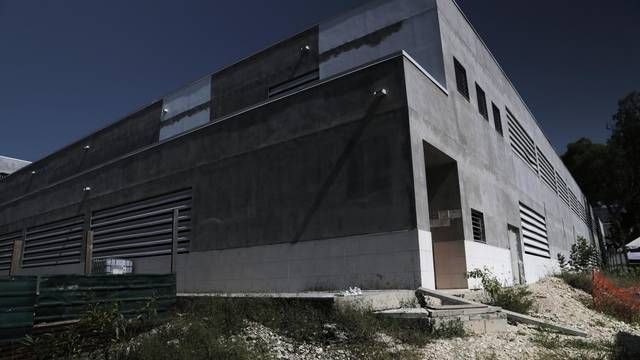PORT-AU-PRINCE
One of the first projects approved for Haiti’s reconstruction following the cataclysmic earthquake of Jan. 12, 2010, was a sprawling new hospital campus rising out of the ground near downtown Port-au-Prince.
A decade later, it has yet to open its doors.
The new Hospital of the State University of Haiti, commonly known as the General Hospital, has been dogged by construction cost overruns, missed deadlines and concerns that Haiti won’t be able to afford operating a massive 534-bed facility that would replace the current general hospital.
Construction of the General Hospital, which would become the country’s largest and replace a transitional structure built after the quake, was approved by the now defunct Interim Haiti Recovery Commission with financing from France, the United States and the Haitian government.
France has committed $40.3 million and the U.S. $25 million. The Haitian government, which had agreed to provide $33.2 million, has so far paid only $22 million.
In July, after five years of construction, the joint venture involving the Spanish firms Elecnor and Teyco, registered in Haiti under the name GISH (Groupement International Santé pour Haiti), shut down the site and terminated its contract, citing $16 million in claims it said Haiti must pay for the company to restart. The complaints range from change orders Haiti demanded to costs the firm says it is incurring because of soaring inflation and the political crisis, which has led to repeated work stoppages amid countrywide lockdowns.
The parties appear to be at a stalemate.
“All of the claims are not just,” said Pierre-Michel Joassaint, the newly appointed director of the government’s Technical Execution Unit, which oversees the contract for Haiti’s finance ministry. “We need to arrive at a reasonable price where we can take into account their demands. We cannot agree to demands that we cannot justify. That’s where we are right now.”
Vicente Ramirez Girbes of Elecnor, which is the lead contractor under GISH, did not respond to multiple requests from the Miami Herald seeking comment.
In all, the project is facing a $27 million construction shortfall. But the funding gap is not the biggest concern for donors, who are providing Haiti with technical advice in the dispute and believe they will be able to mediate a resolution. The donor nations’ biggest worry is Haiti’s ability to support the new hospital in the long term.
The cost of operating and maintaining the 269,097-square-foot structure, built to resist hurricanes and earthquakes, is estimated at $12 million to $18 million annually, with some experts projecting the cost as high as $25 million. That’s a considerable amount of money in a country where the national annual healthcare budget is about $80 million, and officials struggle just to purchase seven truckloads of water every day to wash the floors of the current facility.
“If we manage to finish this project with all of the stakeholders around the table, we would be happy. But then what’s next?” said Anna Lipchitz, the director of the French Development Agencyin Port-au-Prince. “The big question we have right now on the table is how to properly run the new hospital, and that requires a real willingness from the Haitian government.”
The concerns have arisen as Haiti faces political and healthcare crises, the collapse of its economy and an unanswered question: What kind of public health system should the poverty-stricken nation of 11 million be running?
“Should it be a hospital that is autonomous or should it be privatized?” said Franck Généus, a Haitian physician who heads the country’s association of private hospitals.
“One thing that needs to come out of the social and political crisis we are living right now is the reform of the health system,” said Généus, noting that the new General Hospital needs to be at the forefront of that change. “The health system should learn a lesson from all of the dissatisfaction, all that we failed to do between 2010 and 2020, and come with another vision, another approach of how to practice medicine, how to support healthcare in this country.”
High Cost of Earthquake Response
Weak, inadequate and underfunded, Haiti’s health system was already in critical condition when the 7.0 magnitude earthquake struck on Jan. 12, 2010, claiming more than 300,000 lives and leaving 1.5 million injured.
With the humanitarian relief came a flood of foreign doctors and nurses offering free medical care to many who lost limbs and suffered other injuries. Volunteer groups from as far away as Israel set up tented field hospitals that served thousands of people.
But what was free to the population came at a high cost to many non-government healthcare providers who soon found themselves laying off staff, imposing higher fees or closing.
With the disaster magnifying the weakness of the health system, Haiti’s health ministry launched several initiatives with the support of donor nations, among them Brazil and Canada, to improve access to healthcare.
New hospitals were built in the cities of Gonaives and Mirebalais, and in quake-ravaged Jacmel and Port-au-Prince, where Brazil set up three hospitals. Primary healthcare clinics, planned before the disaster, were fast-tracked, and in 2012 a National Ambulance Center to provide quick access to emergency care came online.
But while the ambitious efforts expanded the number of healthcare facilities, they fell short of actually rebuilding the health system, as the government struggled to provide money to operate the new hospitals in Jacmel, Mirebalais and Gonaives.
Today access to quality healthcare remains a significant problem in Haiti. In the past two months the Haitian Community Hospital on Route de Frères in Port-au-Prince stopped receiving patients, and Hospital Bernard Mevs, a private nonprofit in downtown Port-au-Prince, has warned it may be forced to do the same. The Bernard Mevs, which has launched a public campaign for help, blames its financial woes on its own low fees, the growing inability of Haitians to pay for medical care and the state insurer’s failure to pay the medical bills of government employees.
Adding to the strain, Brazil recently told the health ministry that as of the end of 2020 it will hand over to Haiti the three post-quake hospitals it has been operating with the assistance of the United Nations Office for Project Services in Haiti.
The Brazilian government estimates that it has poured about $90 million into Haiti’s health sector since the quake, and had been delaying the handover until the right time. But as often happens in Haiti, there is never a good time to add responsibilities and costs to the government.
“This is one of our concerns now, what’s going to happen to our project when it comes to an end?” Brazil’s ambassador to Haiti, Fernando de Mello Vidal, said. “I am worried.”
A 2017 World Bank study, which called on Haiti to increase its health spending, noted that government health spending has dropped dramatically over the years. It fell from 16.6 percent of the country’s total budget in 2004, which was above the Latin America and Caribbean average, to 4.4 percent in 2016-17.
As overall spending plummeted, the health ministry’s operational budget has been consumed by personnel costs. According to the study and the government’s own data, 87 percent of the health ministry’s operational budget goes just to salaries. That leaves very little money for operating the island’s network of public hospitals, including the General Hospital.
But Haiti’s dismal health budget is only part of the problem. The rapid devaluation of the domestic currency, the gourde, and the fact that Haiti’s Parliament has failed to adopt a budget for the last three years, has added to the challenge.
As a result, one group of Haitians has been squeezed harder than any other, observers say.
“When I Iook at the broader question of the access to healthcare, it is not the government nor the donors who are paying for access to healthcare. It is the middle class here in Haiti,” said Jane Coyne, the former head of mission for Doctors Without Borders in Haiti, referring to the high out-of-pocket costs Haitians incur for often inadequate service. “It’s the money from the middle class that’s allowing the hospitals to function.”
In November, as the political and economic crisis strained medical care in Haiti, Doctors Without Borders reopened a trauma hospital that it had closed the year before. Even with tighter restrictions on who would be admitted this time around — gunshots and open fractures, but no head injuries — Coyne said the hospital received a high number of admissions in its first two weeks. Of those, 60 percent were gunshot victims.
“There is a real crisis in Haiti today in terms of access to all kinds of healthcare,” she said. “There isn’t enough money to ensure whether any hospital, public or private, continues to function properly. We see dysfunction in the public sector just like we see dysfunction in the private sector. Since few patients are able to pay, all hospitals are struggling. Those accepting all patients are overwhelmed, and those requiring payment upfront are nearly empty.”
There is no official count of how many hospitals have closed or are currently nonfunctional. But in November, the 125-bed Haitian Community Hospital became the latest casualty. As Doctors Without Borders was prepping its trauma hospital to reopen, the board of the foundation that had operated the community hospital for 35 years laid off 150 employees.
“It was a vicious cycle,” said Alain Haspil, president of the Haitian Health and Education Foundation, which founded the hospital nearly four decades ago. “You’re robbing from Peter to pay Paul just to try to keep the hospital open. You just keep falling deeper and deeper in the hole and you can never get back on your feet.”
Haspil said the hospital’s problems started with the earthquake. Up to a year of free healthcare, he said, left the hospital without a revenue stream. And just when the foundation thought it was on a path to recovery with the return of paying patients, the political and economic crisis worsened. Adding to the financial woes, the government insurer didn’t always pay.
And then there are those who outright can’t afford medical care.
“Every year we have a day where we give free healthcare. We get 3,000 people who flood our doors. ... We do it on a Sunday. On Monday when we return to normal operations and ask for [$3] for a consultation, you only get 30 people,” Haspil said. “There’s a problem. You see that the people need healthcare but there is no money.”
Haspil said the foundation, which needs about $200,000 a month to run the hospital, has kept a small team to continue to administer an HIV/AIDS program “in the hopes of maybe a miracle.”
Like many, he has visited the area of the new General Hospital, located adjacent to an existing structure that was repaired after the quake and a few blocks away from the razed presidential palace, which hasn’t been rebuilt since it collapsed in the quake. Across the street is the new $6 million Faculte des Sciences, which is part of the State University system and is currently under construction. It’s being funded by the government of Qatar.
Nearby is the $22 million National Campus of Health Sciences, which houses the new medical, nursing, pharmacy and lab technician schools. Built by the U.S. Agency for International Development, it opened in 2017, and can be seen from the second floor of the hospital under construction.
Haspil said the hospital, which consists of 10 solar-powered buildings, is hard to miss. It is a massive empty shell with unfinished floors and long hallways connecting rooms. The floors are connected by stairwells and handicap access ramps. A cafeteria offers both inside and outside views of the capital.
Even in its unfinished state, Haspil said the hospital “is beautiful.” Still, he can’t help but wonder, “Did they think it through? Is there money for this?”
“If you don’t have money to run it, it’s a wasted effort and nothing is going to change,” he said. “Healthcare cannot be free. To give care, the money has to come from somewhere. ... There has to be a structure put in place so that we know where the money is coming from.”
A Cesspool of Nepotism
The questions facing the new General Hospital aren’t just about money. There is also the issue of priority and vision, say observers and critics. They emphasize that if you’re going to train the next generation of physicians in Haiti, it has to be done in a facility run with proper staffing.
With more than 1,000 employees, the current general hospital has earned a reputation as a cesspool of nepotism and political favors.
“People in power, whether it’s a minister or lawmaker, once they want to give someone a job they say, ‘Send them to the General Hospital for me,’ ” said Généus. “You came to have a system that was absolutely ungovernable. The biggest challenge for everyone who has taken the administrator’s job at the hospital has been, how are they going to manage it?”
If the new structure will have any chance at succeeding, this practice, Généus and donors say, will have to end.
An official with the USAID said it has assessed Haiti’s financial and human resources capabilities to effectively maintain and run the hospital. Extensive operational studies have been completed, with a variety of post-construction scenarios for management, staffing and operations.
“USAID is in discussion with partners and faith-based and nonprofit U.S.-based health providers in Haiti about a potential ongoing role for these groups in operations,” said the official, who requested anonymity.
The French government, which was tasked with bringing its hospital management experience to the project, says it has invested a lot of time thinking about various management scenarios, like whether the hospital should be run by a foundation. Officials are also pondering the question: Does the new General Hospital really need 1,200 employees?
Without a functioning government and health minister who can make lasting decisions, however, it has been difficult to get answers.
“Partners will provide assistance to help this hospital open,” Lipchitz, the French development director, said referring to the financing gap. “To fulfill an optimal running of the hospital, the Haitian government has to decide on a strategy both at the hospital level and at the national, health system level.”
Rebuild Now
Some experts have wondered if it would have been better to iron out the existing hospital’s management before rushing to build a new one. Others say they can’t fault those who said, “Rebuild now.”
At the beginning of construction, representatives of the three donors routinely met to discuss financing, equipment and the training of staff, a source who attended the meetings told the Herald. But interest waned as the project experienced a series of lengthy delays, and Haitian health ministry officials stopped showing up for meetings.
That hasn’t stopped the Haitian government, however, from adding to its list of demands, the latest of which is a request for a helipad.
During the recent civil unrest, clashes between protesters and police resulted in tear gas being used inside the current hospital, which also suffered from fuel and medicine shortages. But even before the crisis, the hospital’s operation was problematic.
It often suffers from blackouts, poor service and repeated strikes by disgruntled medical residents. During downpours, it is not unusual to see residents wading through water. It’s also not unusual to see patients sleeping on the floors due to a lack of adequate beds. There are no chairs for cancer patients getting chemotherapy.
Dr. Jessy Colimon Adrien, who runs the current facility, said the new hospital can’t open quickly enough. “We need it,” she said.
Janvier Prosper, 54, who lives in Port-au-Prince and was passing near the hospital district and stopped to look at the rising structure, said the current facility, which doesn’t even have a functioning morgue, “is not a place where people need to go.”
“If you go in there, you need to wear a mask on your face, given the scent that is spilling out,” he said. “It’s not just us who are awaiting the new hospital. It’s all of Haiti that’s waiting on the hospital. My hope is that the Haitian state would collaborate with the foreigners for them to finish the buildings so that the people could get a break.”
The French, Americans and Haitians have all given up on providing a date for when the hospital will open. As part of its dispute, GISH provided a new construction timeline and estimates of costs to complete the project.
One idea that was considered was opening the hospital in phases. But a walk-through of the facility shows that while it may be 85 percent completed, there is still plumbing and electrical work that has to be finished throughout.
Even before construction on the new hospital began, there were challenges. Parts of the old building had to be demolished, land cleared and temporary facilities built. All are part of the $100 million price tag that donors now estimate for the project.
While some of the delays were unavoidable, other issues could have been addressed more quickly by the government’s Technical Execution Unit, the USAID official said. He noted that on several occasions the agency had to put pressure on the unit’s directors to issue notice to GISH that it had 48 hours to fix a problem or risk having the contract terminated.
“We could not get a clear consensus on why there were certain delays,” the USAID official said.
Joassaint, the director of the Haitian government construction oversight unit, doesn’t dispute that Haiti’s public administration moves slowly and that there were lengthy delays in the project, like the time it took for the government to acquire the equipment for GISH to begin the job or pay invoices.
But it’s not all Haiti’s fault, he said. He believes that GISH underestimated the scope of the job and the time it would take to build the hospital.
“If we are here with all of these delays, everyone around the table bears a responsibility. It’s not just that this one is responsible and everyone else is as white as snow,“ he said.
Even if the Haitian government were to agree that there were “a few weeks” in which GISH could not work due to the political crisis that often resulted in bullets flying near the job site, Joassaint said, “a bunch” of the delays were because GISH underestimated the number of people it had to hire.
“They can’t say that we’re responsible for all this,” he insisted. “Our engineers told them they were supposed to have 300 to 350 people working. But when they started, they only had 200 people. Part of it is your choice.”
One of those choices, he said, has to do with the type of roof GISH chose to use in its design. The roof leaks, Joassaint said.
During a Herald reporter’s tour of the site, workers noted that they’ve had to work under difficult conditions. One day 65 bullet casings were found on the project’s premises. The solar panels and rooftop have been riddled with bullets. Instead of regular hard hats, construction workers and visitors must wear bulletproof hats.
Ten years is not that long to be building a hospital, say Joassaint and Lipchitz, who both note that the actual construction didn’t start until 2014. But Joassaint said he understands the frustration of a population that has spent the past decade waiting for a promise to bear fruit.
“It is hard and it’s still sad that after 10 years we still don’t have a building,” he said.
“A hospital is more than just a building. It’s the well-trained personnel, the staff,” said Joassaint. “I understand the building is a symbol, it’s beautiful. But we have to think deeper than that.”
